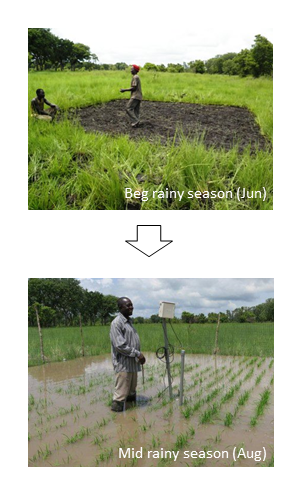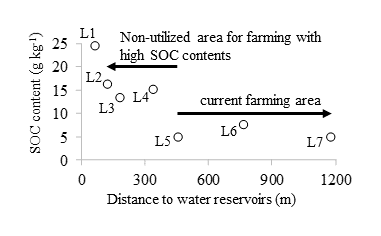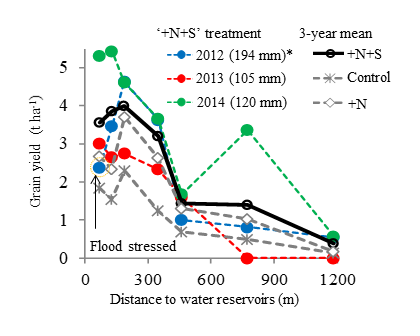Topographical selection and sulfur application enable high grain yields in rice in currently unutilized floodplain ecosystems of northern Ghana
Description
River floodplains in West Africa, most of which are not currently used for farming, are potential land resources for extending rice cultivation areas. The major constraints that limit expansion of crop production in floodplain areas include difficulties in water management and lack of access to tractor services for land preparation at the appropriate timing for planting. In addition, our previous soil survey and pot experiments indicated severe sulfur (S) deficiency for rice production in these land resources (JIRCAS Research Highlights 2012; available at https://www.jircas.go.jp/en/publication/research_results/2012_14). However, there have been no empirical data to demonstrate the potential of rice cultivation in floodplain ecosystems in West Africa. Therefore, three years of field experiments were conducted in no-till and no-bund conditions to determine rice productivity and the responses to different fertilizer applications on various topographical positions in the floodplain ecosystem.
The experimental results are summarized as follows:
- The target floodplain ecosystem is seasonally flooded in nature, without bunding nor an irrigation system (Fig. 1).
- Unutilized land areas with carbon-rich soils are found within 400 m radius of water reservoirs, i.e., back swamps and main river (Fig. 2).
- Rainfall varied widely, with heavy rainfall during the initial growth stage in 2012, a long dry spell during the middle stage in 2013, and consistent rainfall in 2014.
- Grain yields are consistently high in the currently unutilized lowlands close to water reservoirs (L1-L4) under various rainfall conditions and achieve up to 5.4 t ha-1 with N and S application (Fig. 3).
- Sulfur application enhances agronomic N use efficiency (AEN) from 13.4 to 22.8 kg grain per kg N applied, and its effect is particularly large in the currently unutilized lowlands (L1-L4) with AEN values ranging from 28.4 to 32.6 (Table1).
- The grain yields and agronomic N use efficiencies of L1 to L4 are as high as those in irrigated paddy fields in West Africa.
Based on these results, it is concluded that cultivation of rice in the currently unutilized floodplain areas offers good opportunities to increase rice production in West Africa. It should be noted that more quantitative risk analysis for the yield reduction by complete submergence and infrastructural enhancement for the tractor access will be required to facilitate the use of these land resources.
Figure, table
-
Fig.1 Natural flooding during the rainy season in the floodplain ecosystem of Volta river (near L1)
-
Fig. 2 Distance to water reservoirs and soil organic carbon (SOC) contents of seven experimental fields
-
Fig. 3 Effect of topographical condition and fertilizer management on rice yield
*Cumulative rainfall for a month during the initial growth stage from June 15 to Jul 15. The value was highest in 2012 in our observation from 2010 to 2015. In 2012, the L1 field was completely flooded for 6 days just after emergence. -
Values with the same alphabets indicate no significant differences by Tukey HSD (5%). Values are shown as the mean of three experimental years.Table 1. Effect of topographical positions and S application on the agronomic N use efficiency Treatment* L1 L2 L3 L4 L5 L6 L7 mean +N 14.0b 11.0b 23.6a 23.0b 8.7a 8.8b 0.6b 13.4b +N+S 28.8a 32.1a 28.4a 32.6a 10.2a 15.0a 4.0a 22.8a
*N was applied at the rate of 60 kg ha-1 either as urea or ammonium sulfate. S was applied at the rate of 10~68 kg ha-1 as ammonium sulfate or sodium sulfate of which any types or amounts had equivalent effect on rice production.
- Program name
- Term of research
-
FY2017 (2011~2015)
- Responsible researcher
-
Tsujimoto Yasuhiro ( Crop, Livestock and Environment Division )
ORCID ID0000-0001-7738-9913KAKEN Researcher No.: 20588511Oda Masato ( Crop, Livestock and Environment Division )
Katsura Keisuike ( Kyoto University )
KAKEN Researcher No.: 20432338Fujihara Youichi ( Ishikawa Prefectural University )
KAKEN Researcher No.: 10414038Sakagami Junichi ( Kagoshima University )
KAKEN Researcher No.: 70399369Inusah Baba ( Savanna Agricultural Research Institute, CSIR, Ghana )
Fuseini Abraham ( Savanna Agricultural Research Institute, CSIR, Ghana )
Dogbe Wilson ( Savanna Agricultural Research Institute, CSIR, Ghana )
Zakaria Alhassan I. ( Savanna Agricultural Research Institute, CSIR, Ghana )
- ほか
- Japanese PDF
-
A4 461.94 KB
A3 413.38 KB
- English PDF
-
A4 282.67 KB
A3 229.75 KB
- Poster PDF
-
2017_B03_poster.pdf376.59 KB



